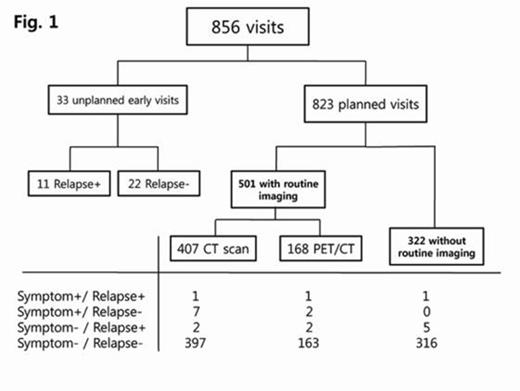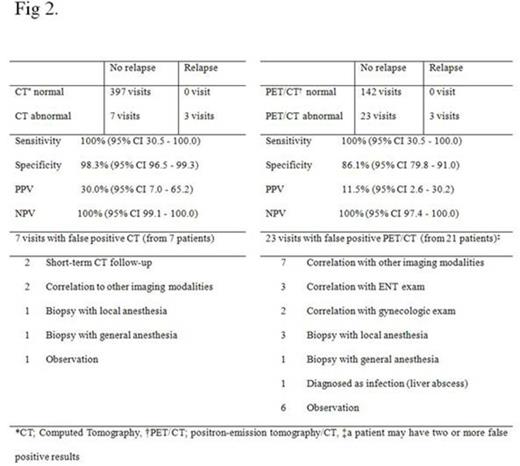Abstract

For patients with aggressive lymphoma in complete remission (CR) after primary therapy, efficient detection of relapse with maintenance of performance status is important because there is the second chance for cure by salvage therapy. Contrary to initial staging workup, treatment, and its response evaluation, there is ambiguity in the field of surveillance of patients with lymphoma in CR: intervals of outpatient department (OPD) follow-up, lists of required laboratory tests, and especially routing imaging by computed tomography (CT) scan or 18F-fluorodeoxyglucose positron emission tomography/computed tomography (FDG-PET/CT), have not been firmly standardized according to experts and guidelines. Despite a lack of evidence, routine imaging (RI) with CT or FDG-PET/CT has been widely adopted. The aim of the current study was to analyze the patterns and outcomes of OPD surveillance and to evaluate the role of RI and unplanned early OPD visits in patients with diffuse large B-cell lymphoma (DLBCL) in remission.
Patients 1) diagnosed as DLBCL according to 2008 WHO criteria, 2) age °Ã 20 years, 3) achieved CR according to 2007 Revised Criteria after receiving R-CHOP immunochemotherapy with or without following radiotherapy or high dose therapy, and 4) had °Ã 1 OPD visit for the surveillance of relapse, were included. The institutional policy of OPD visits in patients with DLBCL in CR was as follows: OPD visit every 2 to 3 months for the first 2 years, then every 4 to 6 months for the next 3 years, and annually thereafter. History taking, physical examination, and checking complete blood cell count were performed routinely during each visit. Every single OPD visit was reviewed and classified with regard to whether or not it was planned. If an OPD visit was scheduled during the last OPD visit for purpose of surveillance of asymptomatic patients, the visit was classified as a 'planned OPD visit'. An 'unplanned early visit' was defined as any OPD visit earlier than the appointed next visit decided by the patient because of any abnormal symptom or sign. RI was defined as a CT or FDG-PET/CT scheduled by a physician at least 2 months prior to actual scanning for routine surveillance of lymphoma, i.e., without any symptom or sign of relapse. There was no specific institutional policy of RI, and three physicians (Hong J, Park J, and Lee JH) decided whether or not to perform RI during the next visit with consideration of the patient's opinion.
One hundred and six patients diagnosed between May 2004 and February 2012, satisfied the inclusion criteria. During a median follow-up duration of 38.1 months, 15 patients (14.2%) experienced disease relapse. A total of 856 OPD visits (median 6, range 1-25) were analyzed from the 106 patients; 501 visits were planned OPD visits with RI, 322 visits were planned visits without RI, and 33 visits (33/856 = 3.9%) were unplanned early visits (Fig. 1). RI showed a perfect sensitivity and negative predictive value but low positive predictive value due to frequent false-positive results (Fig. 2). Six of seven patients who underwent routine CT scan and 17 of 21 patients who underwent a surveillance FDG-PET/CT received unnecessary further evaluations, even including biopsy with general anesthesia. Compared to enhanced CT scan, FDG-PET/CT showed a higher rate of false positive results [7/407 (13.7%) for CT vs. 23/165 (13.7%) for FDG-PET/CT]. Unplanned early visits of patients showed a strong association with disease relapse compared to planned OPD visits; one third of the unplanned early visits were due to disease relapse (Fig 3). Due to the small number of patients, it was impossible to determine whether RI can prolong the survival of relapsed patients with DLBCL, although there appeared to be no significant difference between the groups.
Considering limited diagnostic values in addition to the risk of radiation exposure, financial cost, and anxiety of the patients, RI appears not to be an ideal strategy for surveillance in patients with DLBCL who achieved a CR in the rituximab era. Clinical symptom or sign-directed surveillance can be more useful in detecting relapse compared to RI, at least in patients with DLBCL in remission. It should be emphasized that patients should be encouraged to visit the hospital earlier if they experience any discomfort.
Off Label Use: lenalidomide in newly diagnosed myeloma.
Author notes
Asterisk with author names denotes non-ASH members.

This icon denotes a clinically relevant abstract




This feature is available to Subscribers Only
Sign In or Create an Account Close Modal